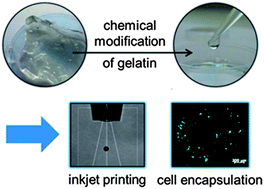Chemical tailoring of gelatin to adjust its chemical and physical properties for functional bioprinting
Abstract
Double chemical functionalization of gelatin by methacrylation and acetylation of free amino groups enables control over both the viscous behavior of its solutions and the mechanical properties of the resulting hydrogels after photochemical crosslinking. The degree of methacrylation is controlled by the molar excess of methacrylic anhydride applied. Tenfold molar excess leads to highly methacrylated gelatin (GM10), resulting in solutions with low viscosities within the inkjet-printable range (10 wt%: 3.3 ± 0.5 mPa s, 37 °C) and crosslinked hydrogels with high storage moduli G′ (10 wt%: 15.2 ± 6.4 kPa). Twofold excess of methacrylic anhydride leads to less methacrylated gelatin (GM2) proper for preparation of soft hydrogels (10 wt%: G′ = 9.8 ± 4.6 mPa s) but its solutions are highly viscous (10 wt%: 14.2 ± 1.1 mPa s, 37 °C) and thus prone to clogging printing nozzles. Here we show that additional introduction of acetyl functionalities into GM2 results in a significant decrease in solution viscosity (10 wt%: 2.9 ± 0.2 mPa s, 37 °C) and prevention of physical gel formation. In such a manner twofold functionalized gelatin can be inkjet-printed while the degree of chemical crosslinking remains low and the resulting gels are soft. Thus, by adjustable twofold modification of gelatin, i.e. inserting photochemically reactive and inert groups, a versatile bioink for inkjet bioprinting is created, which allows for addressing ECM based hydrogel matrices with a broad range of physical properties. Moreover, bioinks are proven to be cytocompatible and proper for inkjet printing of viable mammalian cells.


 Please wait while we load your content...
Please wait while we load your content...